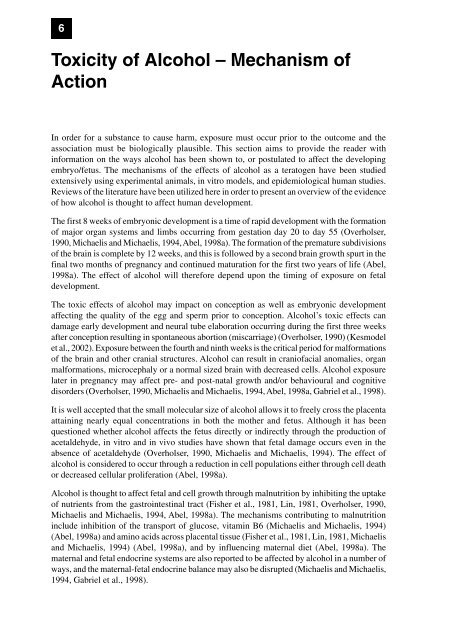Fetal Alcohol Syndrome A literature review - Department of Health ...
Fetal Alcohol Syndrome A literature review - Department of Health ...
Fetal Alcohol Syndrome A literature review - Department of Health ...
Create successful ePaper yourself
Turn your PDF publications into a flip-book with our unique Google optimized e-Paper software.
6<br />
Toxicity <strong>of</strong> <strong>Alcohol</strong> – Mechanism <strong>of</strong><br />
Action<br />
In order for a substance to cause harm, exposure must occur prior to the outcome and the<br />
association must be biologically plausible. This section aims to provide the reader with<br />
information on the ways alcohol has been shown to, or postulated to affect the developing<br />
embryo/fetus. The mechanisms <strong>of</strong> the effects <strong>of</strong> alcohol as a teratogen have been studied<br />
extensively using experimental animals, in vitro models, and epidemiological human studies.<br />
Reviews <strong>of</strong> the <strong>literature</strong> have been utilized here in order to present an overview <strong>of</strong> the evidence<br />
<strong>of</strong> how alcohol is thought to affect human development.<br />
The first 8 weeks <strong>of</strong> embryonic development is a time <strong>of</strong> rapid development with the formation<br />
<strong>of</strong> major organ systems and limbs occurring from gestation day 20 to day 55 (Overholser,<br />
1990, Michaelis and Michaelis, 1994, Abel, 1998a). The formation <strong>of</strong> the premature subdivisions<br />
<strong>of</strong> the brain is complete by 12 weeks, and this is followed by a second brain growth spurt in the<br />
final two months <strong>of</strong> pregnancy and continued maturation for the first two years <strong>of</strong> life (Abel,<br />
1998a). The effect <strong>of</strong> alcohol will therefore depend upon the timing <strong>of</strong> exposure on fetal<br />
development.<br />
The toxic effects <strong>of</strong> alcohol may impact on conception as well as embryonic development<br />
affecting the quality <strong>of</strong> the egg and sperm prior to conception. <strong>Alcohol</strong>’s toxic effects can<br />
damage early development and neural tube elaboration occurring during the first three weeks<br />
after conception resulting in spontaneous abortion (miscarriage) (Overholser, 1990) (Kesmodel<br />
et al., 2002). Exposure between the fourth and ninth weeks is the critical period for malformations<br />
<strong>of</strong> the brain and other cranial structures. <strong>Alcohol</strong> can result in crani<strong>of</strong>acial anomalies, organ<br />
malformations, microcephaly or a normal sized brain with decreased cells. <strong>Alcohol</strong> exposure<br />
later in pregnancy may affect pre- and post-natal growth and/or behavioural and cognitive<br />
disorders (Overholser, 1990, Michaelis and Michaelis, 1994, Abel, 1998a, Gabriel et al., 1998).<br />
It is well accepted that the small molecular size <strong>of</strong> alcohol allows it to freely cross the placenta<br />
attaining nearly equal concentrations in both the mother and fetus. Although it has been<br />
questioned whether alcohol affects the fetus directly or indirectly through the production <strong>of</strong><br />
acetaldehyde, in vitro and in vivo studies have shown that fetal damage occurs even in the<br />
absence <strong>of</strong> acetaldehyde (Overholser, 1990, Michaelis and Michaelis, 1994). The effect <strong>of</strong><br />
alcohol is considered to occur through a reduction in cell populations either through cell death<br />
or decreased cellular proliferation (Abel, 1998a).<br />
<strong>Alcohol</strong> is thought to affect fetal and cell growth through malnutrition by inhibiting the uptake<br />
<strong>of</strong> nutrients from the gastrointestinal tract (Fisher et al., 1981, Lin, 1981, Overholser, 1990,<br />
Michaelis and Michaelis, 1994, Abel, 1998a). The mechanisms contributing to malnutrition<br />
include inhibition <strong>of</strong> the transport <strong>of</strong> glucose, vitamin B6 (Michaelis and Michaelis, 1994)<br />
(Abel, 1998a) and amino acids across placental tissue (Fisher et al., 1981, Lin, 1981, Michaelis<br />
and Michaelis, 1994) (Abel, 1998a), and by influencing maternal diet (Abel, 1998a). The<br />
maternal and fetal endocrine systems are also reported to be affected by alcohol in a number <strong>of</strong><br />
ways, and the maternal-fetal endocrine balance may also be disrupted (Michaelis and Michaelis,<br />
1994, Gabriel et al., 1998).

















